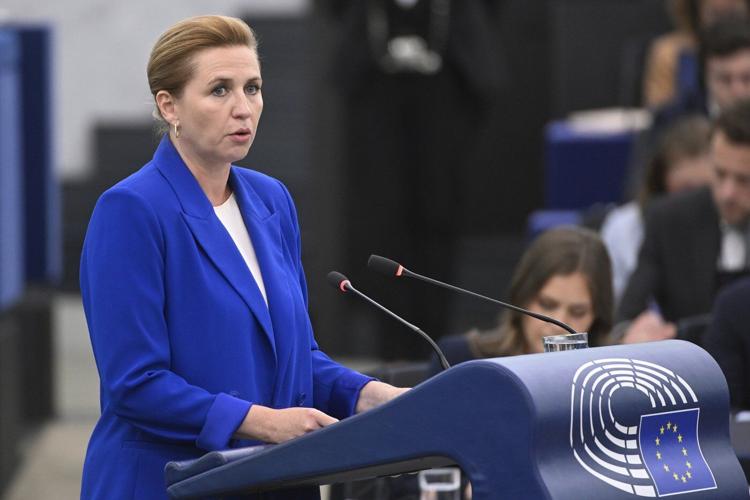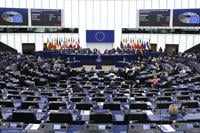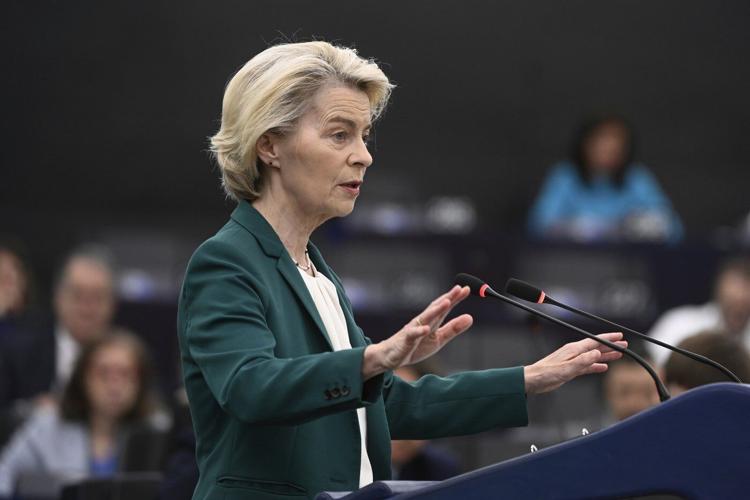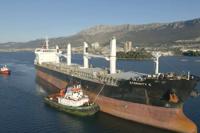BRUSSELS (AP) — Russia could pose a credible security threat to the European Union by the end of the decade and defense industries in Europe and Ukraine must be ramped up within five years in preparation, Danish Prime Minister Mette Frederiksen warned on Tuesday.
In a speech to the European Parliament marking the launch of Denmark’s six-month term as holder of the , Frederiksen lamented that “cutting our defense spending in the past 30 years was a huge mistake.”
European officials have that President Vladimir Putin could soon try to test NATO’s — the pledge that an attack on any one ally would be met with a collective response from all 32. Most of the allies are EU countries.
Russia has been accused of acts of sabotage, cyberattacks and fake news campaigns – largely to weaken European – and while Europe is not at war, it is either, NATO Secretary-General Mark Rutte has said.
“Strengthening Europe’s defense industry is an absolute top priority, and we have to be able to defend ourselves by 2030 at the latest,” Frederiksen told EU lawmakers in Strasbourg, France. “Never, ever should we allow Europe to be put in a position again where we cannot defend ourselves.”
Many European leaders insist they have heard the that American security priorities now lie elsewhere – in the Middle East and the Indo-Pacific – but Europe’s effort to arm is moving only slowly.
When NATO’s ambitions are not enough
At a last month, NATO leaders endorsed a statement saying: “Allies commit to invest 5% of GDP annually on core defense requirements as well as defense- and security-related spending by 2035 to ensure our individual and collective obligations.”
That historic pledge will require them to spend tens of billions of euros (dollars) more over the coming decade, not five years. Spain – NATO’s lowest spender with 1.28% of GDP last year – quickly branded the target
Belgium has cast doubt over whether it will make the grade. Slovenia is considering a referendum. Heavyweights France and Italy are mired in economic woes and will struggle to get there too.
Money spent on military support to Ukraine can now be included in NATO’s defense calculations, but even that will not hike the GDP military spend by much.
The EU’s Readiness 2030 plan
With the threat of Russian aggression in mind, the EU’s executive branch has come up with . It hinges on a 150-billion-euro ($176 billion) loan program that member countries, Ukraine and outsiders like Britain could dip into.
It aims to fill gaps that the U.S. might leave. Spending priorities for joint purchase include air and missile defense systems, artillery, ammunition, drones, equipment for use in cyber and electronic warfare, and “strategic enablers” like air-to-air refueling and transport.
On Tuesday, 15 EU countries were permitted to take advantage of another measure — a “national escape clause” — to allow them to spend more on defense without breaking the bloc’s debt rules.
Beefing up ’s defense industry is also a pillar. The country produces arms and ammunition faster and more cheaply than its EU partners. Kyiv estimates that 40% more of its industrial capacity could be exploited if Europe were to invest.
Still, ambition is one thing, and the reality another.
“Things are not moving fast enough to be able to defend ourselves in 5 years,” Danish Defense Minister Troels Lund Poulsen told reporters last week. “It’s a huge, huge challenge to reach that goal.”
On the need to take risks
A big part of the problem is that governments and the defense industry are stuck in old ways of thinking and neither wants to take a risk, even with Europe’s biggest land war in many decades still raging in its fourth year.
“You cannot expect industry to invest in production capacity if you don’t have long-term orders,” said Joachim Finkielman, the director of Danish Defense and Security Industries.
“If you need to build new factories, if you need to engage a larger workforce, you need to make sure that you have that,” he told The Associated Press on Friday.
Demand for 155mm artillery shells is a typical example, Finkielman said. “When you see the kinds of orders that have been placed around Europe, it is two to three years out in time,” he said, while industry needs five to 10 years’ worth of orders to take a chance.
Finkielman said that if governments and industries in Britain, France, Germany and Italy start to move, “the rest will follow.”














































